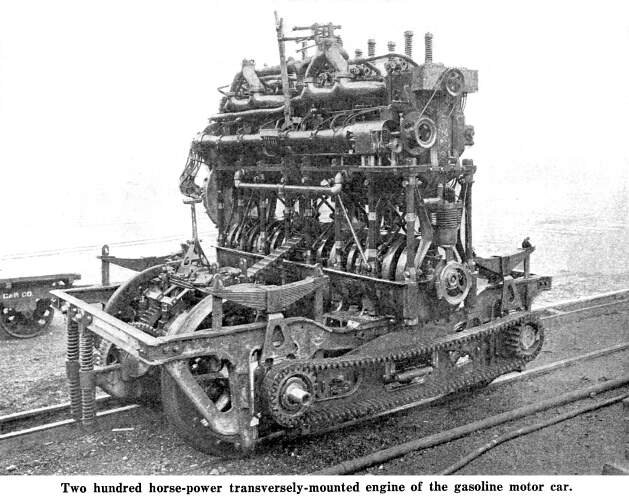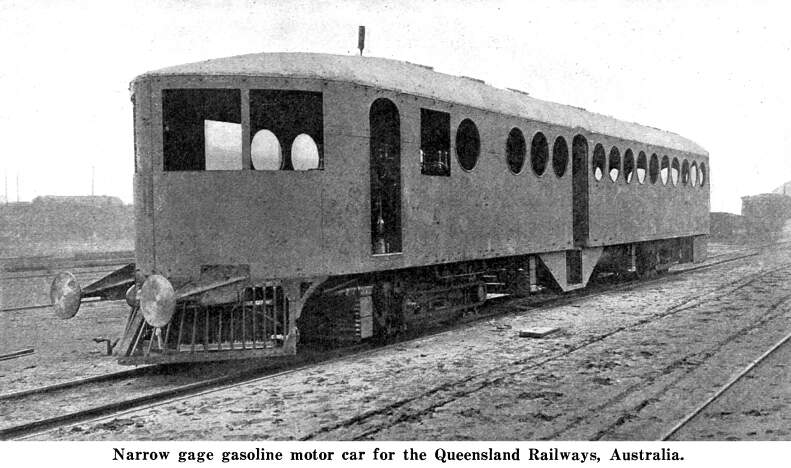A Narrow-gage Self-propelled
Passenger Coach
A Novel Car with Transversely-mounted Motor
by Stanley Petman, M. E.
Scientific American—April 12, 1913
WITH the practical perfection of Dr. Rudolph Diesel's internal-combustion
locomotive, which already has undergone successful tests in Germany,
greater attention is bound to center on the self-propelled passenger
coach utilizing comparatively cheap oil fuel, or even gasoline,
for it has been demonstrated that the total operating expense
of vehicles of the latter type, employing the lighter hydrocarbons,
can be reduced to nearly one quarter that of a steam locomotive
with one car and half that of an alternating current coach.
Although gasoline-propelled passenger coaches of standard size
and gage are used to a considerable extent, additional interest
attaches to the car, of which a photograph is reproduced herewith,
by reason of the fact that it was constructed for special purposes
which restricted the permissible gage to 3 feet 6 inches instead
of the standard 4-foot 8½-inch gage. It is one of five
recently shipped t o Australia for service on the Queensland government
railways, and though its principal point of difference from others
of its kind lies in its narrow gage, its construction also incorporates
a number of other interesting features.
 Thus, for instance, the engine
is placed transversely to the chassis instead of longitudinally
as is the usual practice. It is a massive six-cylinder motor with
a bore and stroke of 10 inches and 12 inches, respectively. It
drives all four wheels of the forward truck through the intermediary
of a multiple disk clutch and a simple two-speed gear which permits
the necessary reduction for starting and plow running. The transmission
of power between the two pairs of wheels, as may be seen by the
accompanying photograph, is by Morse silent type chains, and it
is understood that the mechanical efficiency of the arrangement
is as high as 96 per cent. The engine is rated at 200 horse-power,
and as it is air-starting and reversing, no provision for a reversing
gear is necessary. The remainder o f the power unit embraces 3-foot
steel-tired, cast-steel center driving wheels carried in 6 by
10-inch journals; the wheelbase of the trucks is 6 feet and of
the complete car, 40 feet. Thus, for instance, the engine
is placed transversely to the chassis instead of longitudinally
as is the usual practice. It is a massive six-cylinder motor with
a bore and stroke of 10 inches and 12 inches, respectively. It
drives all four wheels of the forward truck through the intermediary
of a multiple disk clutch and a simple two-speed gear which permits
the necessary reduction for starting and plow running. The transmission
of power between the two pairs of wheels, as may be seen by the
accompanying photograph, is by Morse silent type chains, and it
is understood that the mechanical efficiency of the arrangement
is as high as 96 per cent. The engine is rated at 200 horse-power,
and as it is air-starting and reversing, no provision for a reversing
gear is necessary. The remainder o f the power unit embraces 3-foot
steel-tired, cast-steel center driving wheels carried in 6 by
10-inch journals; the wheelbase of the trucks is 6 feet and of
the complete car, 40 feet.
Another point of difference between this car and others is
that the position of the operating levers has been reversed for
left side control. Also, instead of the standard Master Car Builders'
Association's couplers, a side type of buffing gear with draw
hook and screw couplings is employed.
The total capacity of each car is 69 passengers, of which 55
are accommodated in the main compartment and the remaining 14
in the smoker, which is next to the operator's "cubby hole."
To facilitate the handling of passengers at elevated as well as
at roadside stations, the center entrance is depressed, the step
coming very close to the ground. Artificial illumination is provided
by a complete self-contained electric lighting system.

The weight of the car is 60,000 pounds and its principal dimensions
are as follows: Length over end-sills, 59 feet; length over buffers,
62 feet 5¼ inches; width over sheathing, 8 feet 9 inches;
length of passenger compartment, 31 feet 7-and-three-eighths inches;
length of smoking compartment, 8 feet 9 inches; inside height
from floor to ceiling, 7 feet 8½ inches; distance between
center plates, 34 feet.
The cars were shipped to Australia completely "knocked
down" and will be set up on arrival by an expert in the employ
of the manufacturers.
Stories Page | Contents Page
|







